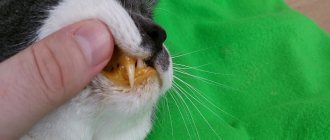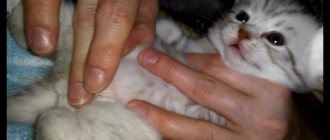Causes that cause sarcoptic mange
Any disease has reasons why it arose. Sarcoptic mange is no exception - any dermatitis is caused by any factors. Knowing the cause, it becomes possible to prevent the onset of the disease.
Sarcoptic mange is caused by the activity of the mite Sarcoptes canis . This parasite gets under the skin of the animal and begins to actively terrorize its skin. It is impossible to notice it with the naked eye
, since these ticks are very small in size, the route of transmission of this disease is through contact of an infected animal with a healthy individual.
While walking
, a cat, interacting with other animals, can easily become a victim of Sarcoptes canis; the tick will instantly find refuge on the body of a new owner.
Therefore, it is necessary to monitor your animal while walking. Also, when mating a cat and a cat , you need to make sure that the partner does not have sarcoptic mange. In addition to direct contact, infection is possible through contact with objects on which the pathogen is located. For example, if a cat appears in an area where Sarcoptes canis is present , consider it sick.
Symptoms and signs
Important!
This disease does not depend in any way on geographical location.
This disease of our little furry brothers is found absolutely everywhere. Young individuals are more susceptible to the disease.
Important!
Sarcoptic mange is predominantly a disease typical of dogs. It is rare in cats. But notoedrosis, on the contrary, often affects domestic cats.
Symptoms
The symptoms of diseases are different; they can be both hidden and visible. Sarcoptic mange is characterized by some features of its manifestation in the cat's body. Knowing the symptoms, the owner has the opportunity to respond to the body’s signals as quickly as possible and provide timely assistance. The sooner the doctor examines the animal, the faster he can help him.
. Under no circumstances should you self-diagnose or self-medicate your pets. The use of any measures without certain knowledge and skill will only aggravate the situation and worsen the condition of the animal. Don't tempt fate and trust the professionals.
- Below are the main signs of sarcoptic mange:
- hair loss;
- the appearance of cracks on the body - due to a disruption in the normal balance of substances in the skin tissue, the formation of crusts is possible, from which fluid is noticeably discharged;
- itching is a side effect of the parasite Sarcoptes canis;
- apathy - against the background of general malaise, the animal’s physical activity decreases;
- loss of appetite - also observed against the background of general malaise;
- temperature - formed crusts can provoke itching. A cat can scratch them and introduce an infection inside. Elevated body temperature may indicate an inflammatory process;
- weight loss - due to decreased appetite and exhaustion of the body under the influence of Sarcoptes canis, a decrease in the animal’s own weight is observed;
- red spots - redness on the skin may initially be perceived as an allergic reaction to a certain pathogen. But in reality, these are places of tick invasion. It is these places that the cat scratches more than others;
- condition of the coat - the animal’s fur becomes less neat and takes on a sloppy appearance.
IMPORTANT! If symptoms of sarcoptic mange are detected, it is recommended to disinfect all furniture and objects on which the mite may settle. This will help prevent the animal from becoming infected again.
Pathogen
Sarcoptic mange in cats is caused by the micromite Sarcoptes Arctopoda. This parasite settles on the skin of an animal, getting there from the external environment or through contact from another animal. It begins to actively multiply there, forming large colonies and feeding on the beneficial substances of the host organism, that is, the cat. The lifespan of one tick is no more than 55 days, but during this time it manages to produce many offspring and the colony will grow significantly.
The causative agent of sarcoptic mange
The female parasite penetrates the stratum corneum of the skin. There they lay eggs, which mature in about 3 days. They then hatch into a larva, which molts after 4 days and turns into a nymph. Over the next few days, the nymph molts several more times and grows into an adult capable of reproduction. When a sufficient number of parasites appear and reproduce on a significant scale, feline sarcoptic mange develops.
It can be transmitted to humans. However, the environment on human skin is not natural and unfavorable for him. As a result, the parasite cannot reproduce, it simply lives out its life cycle and dies. However, during its life, some products are released that can cause an allergic reaction in humans. It goes away on its own, without treatment.
Diagnosis of the disease
Before prescribing treatment, it is necessary to conduct a diagnosis. Skin diseases have many similarities. Therefore, it is important to make a correct diagnosis. The professionalism of the attending physician can become a key link in this case. If the diagnosis is erroneous, the disease will not only not be cured, it will progress and may provoke disruption of other functions of the body. A number of examinations are used for diagnosis
, which helps to identify the true cause.
- Let's look at the main diagnostic measures:
- initial examination by a veterinarian - the doctor visually examines the patient and assesses his condition and the condition of the skin. It is necessary to tell how your pet’s condition has changed over the last 72 hours, this will help the veterinarian create a more detailed picture when diagnosing the disease;
- blood tests - after taking a blood test, the doctor looks at changes in indicators, some numbers may indicate changes in the functioning of internal organs, as well as indicate an inflammatory process in the body;
- Microscopic examination of skin scrapings is probably the most basic procedure that helps to identify sarcoptic mange from other diseases. Using a scalpel, material is taken from the affected area and examined using a microscope.
If there are suspicions of concurrent diseases, additional studies may be prescribed.
Treatment
This disease can be completely cured. This is already making me happy.
Preliminary preparation
First, some veterinarians advise (and rightly so!) to wash the animal with shampoo. This procedure washes off:
- dead epidermis;
- crusts;
- fallen fur.
If necessary, crusts should be removed with tweezers. This can be done by the owner himself or the veterinarian.
Local treatment
According to reviews, medications that contain selamectin or other insecticides are effective.
The desired form of release is drops. They need to be dripped onto the withers. Treatments must be repeated once every 2 weeks, duration of use is at least 2 months. For the treatment of this type of scabies it is recommended:
- Stronghold (selamectin 6%);
- Advocate (imidacloprid 10% and moxidectin 1%).
Some topical medications can be applied directly to the affected areas of the skin three times (with an interval of 2 weeks between doses):
- Lime sulphide 2-3%;
- Amitraz 0.05%;
- Phosmet 0.09%.
Amidel-gel Neo is an inexpensive and quite effective remedy.
Systemic treatment
Systemic medications should only be used under the supervision of a physician and only after the owner has been explained the likely risks.
An example of such a drug is Ivermectin. The injection is very painful, and the medicine itself is toxic.
Maintenance therapy
The veterinarian can prescribe medications that will restore and protect the animal’s skin in the future.
Examples of them are:
- feed sulfur;
- fatty acid;
- other vitamin and mineral supplements.
Sometimes animals may need sedatives.
How to treat sarcoptic mange in cats
Once the diagnosis is made, the veterinarian must prescribe treatment . Before using drug treatment, all conditions for successful recovery
.
First of all, it is necessary to isolate the cat from other animals that are in the apartment; if there are none, it is still better not to risk it and place the animal in a separate room
.
In areas affected by ticks, the hair is cut off
.
It is also necessary to thoroughly wash your pet with a special shampoo (wash only with protective gloves
, since there are diseases that can be transmitted to humans).
Speaking about the use of drugs in the treatment of sarcoptic mange , we can highlight the most famous of them:
- Aversectin ointment is a very good way to get rid of ticks. The ointment is applied in courses until the pet is completely cured. Specific recommendations with doses and duration of use should only be given by a veterinarian;
- Advocate is drops that are applied to the body, in the area between the shoulder blades. This drug not only relieves the animal of sarcoptic mange, but also has a preventive effect against infection the next time;
- sulfur ointment - known for its positive qualities in relation to the treatment of sarcoptic mange. It also has a restorative and moisturizing effect on the skin.
There are many treatment methods. Drugs may also differ in both names and composition. When treating sarcoptic mange, it is very important to use high-quality products
, which will guarantee the quality of treatment.
Our veterinary uses only certified products
purchased from the manufacturer.
Treatment
Therapy starts with cleaning the affected area for applying external medications - cutting the hair. It is important not to miss a single area of inflammation, otherwise it will become a source of new spread of the parasite. Before applying external medications, soak the crusts with shampoo, Perhydrol or Furacilin solution.
The concept of treatment is to kill the parasite, eliminate signs of disease and restore the cat's health. The following systemic external drugs are in demand:
- Amitrazine.
- Amit - Forte.
- Demos.
- Ivermek-gel.
- Drops on the withers.
Amitrazine
Active ingredients: Dimexide and Amitraz. The solution is applied with a swab to the damaged sectors of the cat’s skin, covering the border areas >10 mm wide. The manipulations are repeated after 3 days until recovery. Seven treatments are enough.
It is important to prevent licking of the medicine for 15 minutes until the active ingredients are absorbed. The cat's face is isolated using an Elizabethan collar or a rope loop draped over the jaw.
Demos
It is a liniment with an oily consistency. The main active ingredient is Sulfur, additional Dimethyl sulfoxide, Carbon tetrachloride, Vaseline.
Rub the medicine from the periphery to the center, covering a strip of intact skin >10 mm wide. After 6 days, the treatment is repeated. Three treatments are usually sufficient.
Ivermek-gel
The combination of the acaricidal effect of Ivermectin (Aversectin), wound-healing Panthenol and analgesic Lidocaine promotes rapid healing of areas of skin damaged by itching. This is a yellowish gel-like mass. It is used with a frequency of 5...7 days. To exterminate Sarcoptes and eliminate the consequences of its parasitism, 2…4 treatments are sufficient. Some cat breeds are hypersensitive to Ivermectin.
Drops on the withers
- Advocate
- Helmintal K.
- IN-AP complex.
- Stronghold.
- Dironet.
If Sarcoptic mange is advanced and complicated by secondary microflora, symptomatic medications are used:
- Antimicrobial agents.
- Antimycotics.
- Immunostulants.
Prevention
Better than any competent treatment is the absence of disease. Preventive measures are a powerful weapon in the hands of owners, which can prevent the occurrence of not only skin diseases, but also many others. All recommendations are compiled by leading veterinarians in our country and have a wide range of application. Let's look at some of them.
- What to do to prevent sarcoptic mange:
- monitor the animal’s diet - a complete, balanced diet, rich in vitamins and minerals, helps strengthen the cat’s immunity, which is very important in the fight against any disease;
- conditions of detention are probably the main factor that must be taken into account when talking about sarcoptic mange. The pet should not come into contact with stray animals or interact with objects that may contain ticks. When mating animals, it is necessary to ensure the health of the partner;
- use of drugs - annual use of drugs that prevent the appearance of ticks and other parasites on the body and in the animal’s body, significantly affect the pet’s quality of life, making it better;
- visiting a veterinarian - a timely visit to a veterinarian helps monitor the general health of the cat and detect diseases in the early stages, increasing the chances of recovery.
Conclusion
Prevention is easier than treating this disease. If only because many pets get incredibly nervous when they are put on a special collar. And without this there is no way. How else can you prevent a cat from licking medicated skin?
Illnesses in pets cause great concern for owners. Most do not pose a danger to humans, but bring a lot of suffering to animals. A common disease in cats is sarcoptic mange, a type of mange caused by parasitic mites of the genus Sarcoptes. Microscopic creatures, feeding on epidermal cells, with the help of powerful jaws are able to make passages in the skin of the animal.
Severe itching leads to scratching of the affected area, creating a risk of infection and the development of sepsis.
Parasites multiply quite quickly. The lack of appropriate measures to combat them or untimely treatment can bring the cat to complete exhaustion.
The harmful effects of parasites
Ticks of the genus Sarcoptes are eyeless, light gray creatures measuring 0.2-0.5 mm in size. Their main “weapon” is their proboscis, with which they bite into the animal’s skin, “drilling” deep passages in it. Parasites do not live very long - from 1 to 1.5 months, leaving behind a huge offspring. A disease in which these mites settle in the epidermis and actively reproduce in its thickness is called sarcoptic mange. Cats are parasitized by Notoedres, a species of the Sarcoptidale family. Therefore, it is more correct to call the cat disease notoedrosis.
How does infection occur? In most cases, a feline becomes infected on the street from a sick individual. Even a domestic cat is at risk of picking up ticks. This can happen when a pet runs out onto the stairs, encountering a sick animal head-on, or becomes interested in the place where the “sick” animal used to lie. He sniffs it, can rub it - and the parasites are already on the fur of the domestic cat. The essence of ticks is such that they can live outside the epidermis for up to 8 hours and infest a healthy cat by moving onto it from an infected one.
This is interesting! When exposed to frost and “fried” in the sun, the parasites quickly die. If your cat is overcome by Notoedres, then its bedding, as well as other objects with which it has been in contact, can be frozen or taken out into bright sunlight. It is enough to even leave these things on the balcony for 2-3 hours to destroy ticks.
Meanwhile, the furry friend returns home from the stairs or the street already infected. No one will notice the parasites on it; they strive to get under the skin of their “master” and multiply there. At the same time, sarcoptic mange and notoedrosis in cats are quite difficult to determine, because it is very similar to the symptoms of food allergies: redness, itching, itchy eyes.
Further - worse. After a few days, characteristic blisters appear near the nose and on the ears, which quickly burst, leaving behind scabs. They begin to itch very much, and the animal, scratching itself, spreads parasites throughout the body. The affected areas dry out, hair falls off in itchy areas, and scabs form extremely unattractive ulcers. But the worst thing is that the poor cat experiences constant itching, which leads him to nervous stress.
The pet sleeps and eats poorly, quickly loses weight, and becomes lethargic. Within a few days, the animal is covered with scabs and bald patches, and its open wounds are a breeding ground for new parasites.
There is no need to console yourself with the thought that sarcoptic mange does not occur in people. Yes, Sarcoptes mites, having transferred to human skin, cannot reproduce, since this is the epidermis of a non-specific “host”. Simply put, they die on the human body. However, when in contact with a sick animal, the owner of a furry pet runs the risk of getting pseudo-scabies, the symptoms of which persist for up to 4 months: redness, rash, itching. Children may develop allergies after contact with an affected cat.











